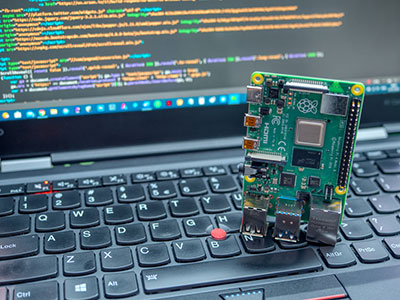With the rising demand to build smaller devices while packing more technology into them, there is a need to develop more compact PCBs. Currently, applications requiring small circuit boards rely on HDI (High-Density Interconnection) PCBs, but these are still not small enough. However, there is a solution. helps mSAP PCB miniaturize further, enabling them to hold more components while leaving more space for batteries and other parts in portable devices.
We have covered the technology in detail and how it differentiates from the conventional etching method below.
Contents
What are SAP and mSAP?
SAP and mSAP are emerging technologies in flex, rigid, and rigid-flex PCBs. We must define the subtractive etch process briefly to understand the two technologies.
Subtractive etching is the traditional PCB fabrication technique. It involves starting with the laminate (copper and polyimide), usually 0.25 ounces or more. After that, the circuit pattern gets formed by etching out the unwanted copper to create the patterns/copper traces.
However, the SAP (Semi Additive Process) involves adding a copper layer to the dielectric to create the circuit pattern. Therefore, it is an additive process (hence the name).
The mSAP technology (Modified Semi Additive Process) only differs from SAP in the seed copper layer formation. The layer is slightly thinner on SAP, and fabricators use the flash electroless copper process to make it. However, the laminar starts with a relatively thicker layer of copper bonded to the substrate in mSAP.
What is the Benefit of SAP and mSAP?
- Capable of making plated through holes with similar-sized welding rings or without rings (ideal for large plated through holes)
- Creates finer traces than subtractive etching (thin line widths measuring 5um and below)
- Capable of creating high aspect ratio PCBs with tighter features (suitable for boards with thick surface copper and thick wall copper)
- Produces clean and straight traces (not trapezoidal)
Special Offer: Get $100 off your order!
Email [email protected] to get started!
Difference Between SAP, mSAP, and Conventional Subtractive PCB Processes
SAP and mSAP have some similarities but differ from the subtractive etching process in the following ways.
Subtractive Etching
This process creates fine lines by coating the layer of copper with an etch resist. Additionally, it incorporates the photolithography process for imaging. Photolithography helps determine the areas to retain copper and where to etch the unimaged material.
The main issue with subtractive etching is that the chemical treatment for vertical etching dissolves the copper horizontally along the trace walls.
Therefore, the circuit traces appear trapezoidal from the cross-section point of view with a 25-45° angle from the base. This circuit trace shape can create impedance reliability challenges for 5G frequencies.
Additive
The additive technology involves using the copper plating process to form copper traces on a circuit board printed with the circuit pattern. It primarily focuses on electroless copper plating and the bonding ability between copper plating and the underlying substrate.
This fabrication process is simple because it does not require a copper-clad laminate. Additionally, there's no need to worry about electroplating dispersibility because of the electroless copper plating. There are two variants of additive fabrication.
SAP
The purpose of Semi Additive Processing was to develop finer lines/trace geometries. It involves plating the copper layer on the copper-clad laminate first, then electroplating again while covering the areas that do not need plating. This process is known as pattern plating. The Semi Additive part came about from the requirement of secondary copper plating.
mSAP
mSAP is similar to SAP because it defines trace geometries using photolithography. Remember, the subtractive process does this chemically. Therefore, it creates straight, vertical lines with greater precision, resulting in rectangular-shaped traces along the cross-section. This design maximizes circuit density and allows precise impedance control with minimal signal loss.
mSAP begins with a shallow copper thickness layered on the substrate, followed by a negative pattern design. After that, copper gets electroplated to the required thickness then the seed copper layer gets removed.
In a nutshell, SAP and mSAP are the same. However, SAP begins with a thinner, electroless seed copper layer less than 1.5 um thick. On the other hand, mSAP starts with a relatively thicker seed layer of copper greater than 1.5 um thick.
Potential Applications for Additive Fabrication
The smartphone market is the main application area for mSAP because these devices need smaller and smaller packages as they advance.
Medical devices also require this technology because they require space and weight reduction, especially when developing implants/prosthetics. The technology helps create high-density PCB designs, which reduce the layer count and the number of lamination cycles.
Compact smartphone motherboard designs are the outcomes of merging additive fabrication with the predominant subtractive etching technology. The combination freed up more space to accommodate larger batteries, and if this is possible using the two technologies, what about with mSAP alone?
Trace Width Reduction Trend
The conventional subtractive etching technology can create a trace width of about 40-100μm, while mSAP traces can be about 20-40μm wide. SAP lines are the thinnest of them all, measuring roughly 5-20μm wide.
In addition to being thin, the precisely controlled shape of these copper lines improves signal integrity by minimizing noise and cross-talk.
However, the manufacturing cost for SAP and mSAP is high, so the production scale is low. Therefore, the technology is currently viable for integrated circuits. But as the technology advances, it should become cheaper over time and fast-track the development of 5G, IoT, and other technologies.
Summary
Even though mSAP is an expensive copper trace layering process, it is a new and emerging technology. Therefore, the fabrication technology's cost will eventually reduce, paving the way for the rapid development of critical technologies like 5G. We hope this article has been insightful. If you have any comments, leave a message, and we'll get back to you asap.
Special Offer: Get $100 off your order!
Email [email protected] to get started!







